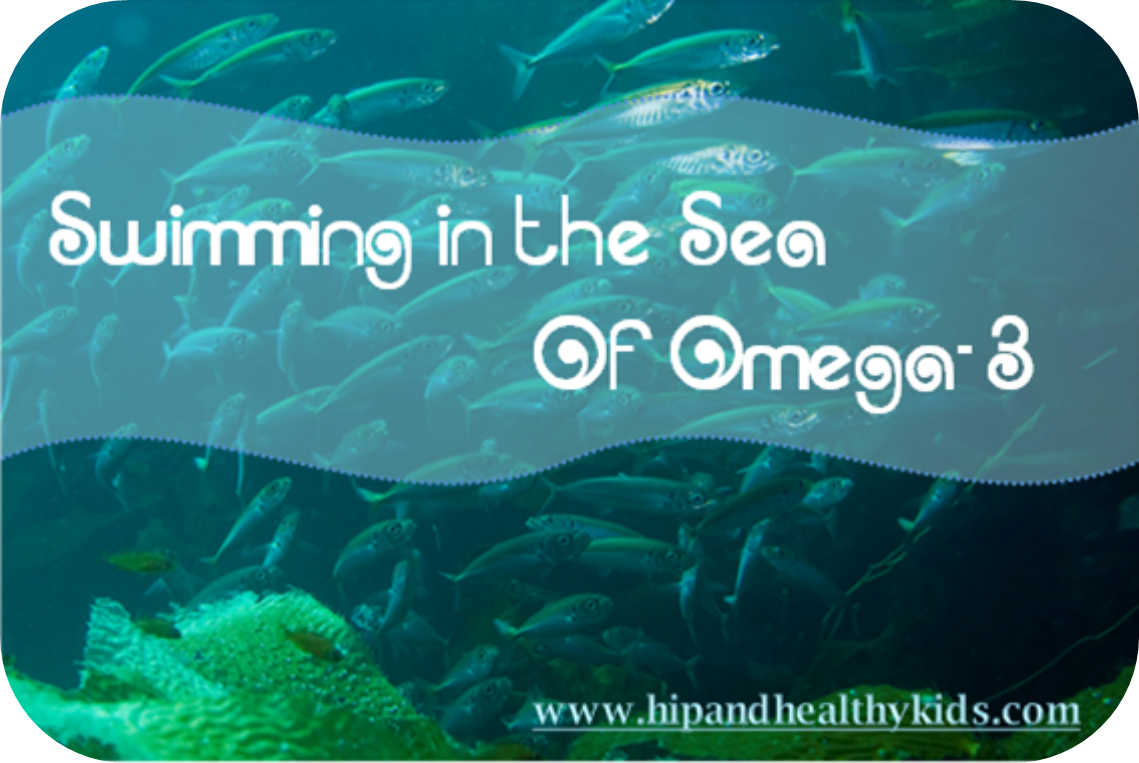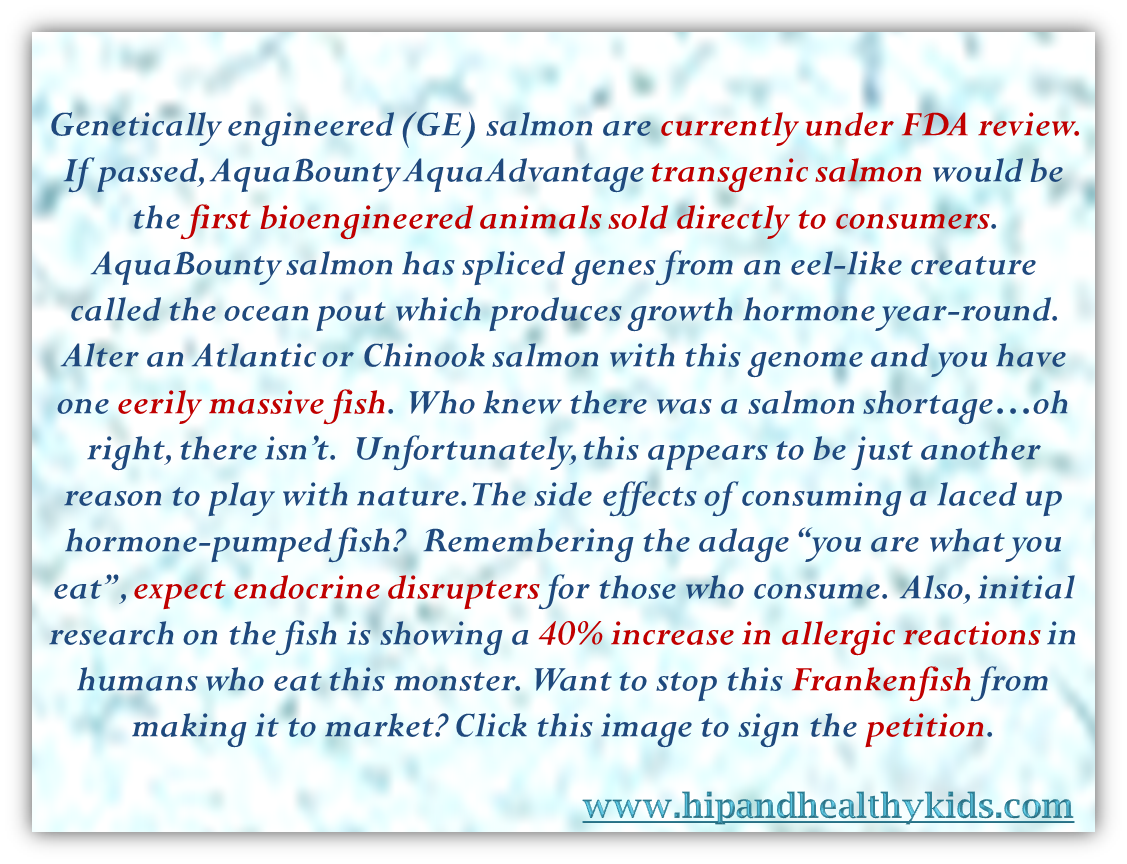Swimming in the Sea of Omega-3
- By hhk
- March 20, 2013
- 8 Comments
Omega-3 fatty acids have long been known to be an essential building block for growth and support for optimal health since the 1930s; however, it was not until the 1990s that this, now well-known nutrient was popularized for its health benefits. In this article we will take a look at the benefits of Omega-3 fatty acids and look at its counterparts (6 and 9). We will also explore preferred food and supplement options for adults and kids to ensure we have this essential nutrient covered in our daily regimen. (Don’t miss the petition below too. You’ll want to weigh in on Frankenfish, I’m sure.)
What are Essential Fatty Acids?
Essential Fatty Acids (EFAs) are the basic building blocks of which fats and oils are composed. EFAs are essential for rebuilding and producing new cells. They are also used to produce prostaglandins which are vital for regulating numerous body processes.
Omega 3 Benefits and Differences from Omega-6 and Omega-9
Omega 3, 6, and 9 are distinctly different unsaturated fatty acids. The number is determined by where the carbon atom binds with the hydrogen and oxygen atoms. 3, 6, and 9 also differ in how they impact the body’s health.
Omega-3 is the most important of the three. 3 is most recognizable for its support of cardiac health as well as how it fosters brain growth and promotes optimal neuron function. Omega-3 also works amazingly with the body to counter inflammation (the root cause of most degenerative diseases). Omega-3 has been demonstrated to:
- Support circulation and healthy blood vessel function
- Promote metabolism of dietary fat and cholesterol
- Support memory and learning ability
- Protect nerve and brain cells from oxidative stress and damage
- Allow for increased focus and attention
- Promote healthy eyes and vision
- Promote joint mobility and flexibility
- Combat inflammation occurrence in the body
- Nourish skin, hair and nails
- Protect against free radical damage
In pregnant women, the demand for EFAs (especially Omega-3 DHA (Docosahexaenoic acid)), increases. Therefore it is critical for pregnant (and lactating) women to have a steady supply of Omega-3. DHA consumed during pregnancy and while nursing sets the foundation for baby’s developing brain and nervous system. Omega-3 will also assist in supporting a woman’s body post-partum.
Children receive the most benefit from essential fatty acids. EFAs consumed by children promote healthy brain and immune system development at the critically important time of rapid growth. Research has found that Omega-3 fatty acids consumed during pregnancy may reduce the risk of allergies and colds in children. Omega-3 support of brain development and function has also been correlated with enhanced learning ability.
Omega-6 is naturally occurring in our food supply. Many people have a large amount of Omega-6 from consumption of vegetable cooking oils. Unless one is taking supplements or eating a high Omega-3 diet, chances are your Omega-3-to-6 ratio is off balance. Omega-6 tends to increase inflammation in the body, so if there is a lack of Omega-3 to counterbalance the 6, then inflammation may potentially lead to a number of disease conditions.
Omega-3 and 6 are not created by the body, Omega-9, on the other hand, can be manufactured by our body from the conversion of unsaturated fats. Omega-9 is abundant in animal fat and olive oil. Typically, we do not need to supplement with Omega-9, nor with Omega-6. We are typically only deficient in Omega-3, so it is much more important for us to focus our attention on Omega-3 foods and supplements, and here’s how.
Dietary Sources of Omega-3
 Walnuts are a standout in the nut family for their significant amounts of Omega-3 fatty acids. One quarter of a cup of walnuts contain 94.5% of the daily recommended value for Omega-3 fats. Use this nut when baking or just snacking to get an Omega-3 boost.
Walnuts are a standout in the nut family for their significant amounts of Omega-3 fatty acids. One quarter of a cup of walnuts contain 94.5% of the daily recommended value for Omega-3 fats. Use this nut when baking or just snacking to get an Omega-3 boost.
You may have heard that flax is a fantastic source of dietary Omega-3. Flaxseed oil, for example, has a 53-62% content of Omega-3. You can utilize ground flax (like we did in this Smoothie), mix it in muffin or bread recipes, or enjoy it in granola. However, it is important to note that flax omega presents itself as ALA (alpha-linolenic acid) which the body is left to convert to EPA and DHA. The body is quite inefficient at converting ALA so you do not want to rely on flax alone as your omega-3 source.
In the Starting a Bag Revolution  Article, we saw how the degradation of everyday plastics in the ocean, impacts the health of fish; but, there are many factors of ocean health and size of fish that should be considered when choosing your next seafood dinner. Some types of fish are more susceptible to accumulating environmental toxins, high levels of mercury, dioxins, and PCBs (polychlorinated biphenyls); therefore, it is important to consider the fish type when determining how to consume omegas. Generally speaking, toxins are higher in larger, predatory fish. So it is best to consume smaller fish to get the optimal levels of omega while avoiding environmental pollutants. Fatty fish like salmon, mackerel, herring, anchovies and sardines are great sources of essential fatty acids. Look for fresh wild caught fish when making your selection.
Article, we saw how the degradation of everyday plastics in the ocean, impacts the health of fish; but, there are many factors of ocean health and size of fish that should be considered when choosing your next seafood dinner. Some types of fish are more susceptible to accumulating environmental toxins, high levels of mercury, dioxins, and PCBs (polychlorinated biphenyls); therefore, it is important to consider the fish type when determining how to consume omegas. Generally speaking, toxins are higher in larger, predatory fish. So it is best to consume smaller fish to get the optimal levels of omega while avoiding environmental pollutants. Fatty fish like salmon, mackerel, herring, anchovies and sardines are great sources of essential fatty acids. Look for fresh wild caught fish when making your selection.
Supplements from the Sea
A fantastic brand for Omega-3 is Nordic Naturals® (NN). What sets Nordic Naturals® apart in the field of Omega oils are a number of important considerations.
Government fish oil quality standards do not exist in the United States; however, Nordic Naturals® adheres to and exceeds the stringent European Pharmacopoeia Standard (EPS) in addition to standards set by the Council for Responsible Nutrition (CRN) and the Global Organization for EPA and DHA Omega-3 (GOED). What this means for you is that you are receiving products that have been thoroughly vetted to maximize quality. NN products show no detectable levels of heavy metals, dioxins, or PCBs. Every batch of oil used in Nordic Naturals® products is third-party tested for environmental toxins and exceeds the international pharmaceutical standards. These supplements have proven to be at least 750 times purer than fish.
Nordic Naturals® manufacturing processes do not use chemicals or excessive heat, and instead use molecular distillation to preserve the natural properties of the oil while removing toxins, ensuring freshness and maximizing taste. All formulas are produced in true triglyceride form to ensure optimal absorption and results.
Additionally Nordic Naturals® utilizes sustainable fishing practices, collecting wild-caught fish from clean waterways. These low on the food chain (and not endangered) fish include Arctic cod, Anchovies, Sardines, and Salmon. (If you want to read more about Nordic Naturals click here.)
Which Supplement is for you?
Here are my top product picks for each circumstance. As a convenience to you, all of these professional products can be ordered at the Hip & Healthy Kids Storefront.
Everyday Omega – Top Choice – Arctic OmegaTM
Arctic OmegaTM is a non-concentrated formula with all your daily constituents. It allows for natural balance and healthy levels of EPA & DHA giving you a total Omega-3 value of 690mg a day (for soft gels) or you can choose the liquid for 1725 mg in 1 teaspoon. I recommend beginning with a soft gel if you have no trouble swallowing supplements.
Prenatal/Lactating Support – Top Choice – Prenatal DHA
 Prenatal DHA provides 450mg of concentrated DHA as well as delivering 400 I.U. of vitamin D3 per serving. These soft gels are smaller so that they are easy-to-swallow. Remember we talked earlier in this article about the importance of this supplement during pregnancy and lactation to support both mother and child.
Prenatal DHA provides 450mg of concentrated DHA as well as delivering 400 I.U. of vitamin D3 per serving. These soft gels are smaller so that they are easy-to-swallow. Remember we talked earlier in this article about the importance of this supplement during pregnancy and lactation to support both mother and child.
Babies – Top Choice – DHA InfantTM
 In both fish and marine algae (vegetarian form), DHA InfantTM can be used for babies and toddlers 5-35 lbs. Dosage can be found on the product profile in the Hip and Healthy Kids Storefront or on the Nordic Naturals® website. Drops can be added to formula or food to ensure babies get DHA needed for healthy development.
In both fish and marine algae (vegetarian form), DHA InfantTM can be used for babies and toddlers 5-35 lbs. Dosage can be found on the product profile in the Hip and Healthy Kids Storefront or on the Nordic Naturals® website. Drops can be added to formula or food to ensure babies get DHA needed for healthy development.
HIP TIP: If you are breastfeeding and taking your Prenatal DHA supplement, your baby is getting some Omega-3 through your milk. If this is the case you can choose to wait to supplement with the drops until introducing solid food.
Kids – Top Choice – Nordic Omega-3 JelliesTM
Nordic Omega-3 JelliesTM in tutti frutti flavor contain 250 mg of combined EPA and DHA in each serving. The jellies contain no artificial coloring, flavoring or preservatives, and are also gluten, yeast and milk derivative free. Be sure to hide these “treats” as your kids will think they are candy. One per day will give kids their necessary Omega-3 allotment.
As always, please consult your personal health practitioner in order to determine the correct application of Omega supplements for you.
REFERENCES:
http://www.webmd.com/healthy-aging/omega-3-fatty-acids-fact-sheet
http://www.pcrm.org/health/health-topics/essential-fatty-acids
http://whfoods.org/genpage.php?tname=foodspice&dbid=81
http://www.nytimes.com/2011/05/30/health/nutrition/30recipehealth.html?_r=0
http://www.heart.org/HEARTORG/GettingHealthy/NutritionCenter/HealthyDietGoals/Fish-and-Omega-3-Fatty-Acids_UCM_303248_Article.jsp
http://www.change.org/petitions/stop-the-approval-of-genetically-engineered-salmon
http://www.huffingtonpost.com/ocean-robbins/is-genetically-engineered_b_2522547.html
http://www.womentowomen.com/healthynutrition/differencebetweenomega369.aspx
8 Comments
Leave a Reply Cancel reply
This site uses Akismet to reduce spam. Learn how your comment data is processed.














Nice ! I signed the petitions also 🙂
[…] MAY ALSO LIKE: The Sea of Omega-3 Whole (Re)Solution Slinging a […]
[…] Bold. Be Beautiful. Sea of Omega-3 Earth Day […]
[…] The Sea of Omega-3 Coca-Cola Demystified Uncle Ben Demoted to Distant […]
[…] Swimming in the Sea of Omega-3 New Swimtrainer Making A Splash […]
[…] ___Refreshing Greens Swimming in the Sea of Omega-3 […]
[…] ___A Sea of Omega-3 __Coca-Cola Demystified NYC Top Organic […]
[…] between dietary sources, Omega 6 & 9, etcetera? All of this was thoughtfully outlined in the Swimming in the Sea of Omega-3 article. A lot of information was contained in this article as well as my picks on where to get […]